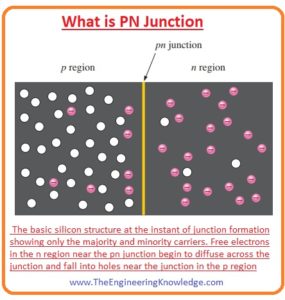 Hello, friends, I hope all of you are having fun in your life. In today’s tutorial, we will explain What is PN Junction. The PN junction is a line between 2 different categories of semiconductors it forms when we doped any semiconductor material with the doping element. If we doped any silicon crystal with the pentavalent impurity and other parts of silicon atom with the trivalent impurity then the boundary among these parts called PN junction.
Hello, friends, I hope all of you are having fun in your life. In today’s tutorial, we will explain What is PN Junction. The PN junction is a line between 2 different categories of semiconductors it forms when we doped any semiconductor material with the doping element. If we doped any silicon crystal with the pentavalent impurity and other parts of silicon atom with the trivalent impurity then the boundary among these parts called PN junction.
The portion of silicon doped with the pentavalent impurity has electron as majority charge carriers and the part of silicone have trivalent impurity have holes as majority charge carriers. In today’s post, we will have a look at its formation, applications in different electronic devices and some other related parameters. So let’s get started with the What is PN Junction.
What is PN Junction
- PN junction is the partition between two different semiconductor material when a single material is doped with 2 different materials.
- Any p-type substance has 2 main materials first one is pure like silicon that is doped with the trivalent impurity such as boron.
- Due to the addition of boron in silicon holes are created in the silicon structure. But due to the equal amount of protons and electrons in complete substance, the total charge is ‘0’ on the substance.
- Similarly in N-type silicon substance, pentavalent impurity is doped and free electrons are available in the structure.
- But due to an equal amount of protons and electrons, the net charge on this substance is still zero.
- If pure silicone material is doped with N impurity as well with the P impurity then the partition among them is known as PN junction it is shown in given figure.
- In p portion, there are numerous holes as majority carriers and N portion electrons are as majority carriers.
Formation of the Depletion Region
- When pn junction has formed the electrons in n portion of PN junction moving in any direction and colliding with other atoms and electrons.
- The electrons close to the junction and high energy they move to the P portion and merge with the hole it shown in a given figure.
- As above we discuss when there is no pn junction created then there are the same number of electrons and protons in N-type substance and have total charge zero.
- This condition is also the same in P-type materials.
- After the creation of junction, the free electrons in n portion cross junction positive ion created and in p side negative ion created due to the combination of electrons and holes.
- In the ‘n’ side due to electrons, movement positive ion layer is produced and in ‘P’ side negative ion layer is generated due to these 2 layers of the ion depletion region is created.
- As you can see that the area of the depletion region is less than as compared to the ‘N’ and ‘P’ regions.
- After a certain time interval movement of electrons from ‘N’ to ‘P’ side stops and equilibrium is created.
- Further movement of electrons holes repelled by the depletion region as its area also increased and positive ion in ‘N’ region repel holes and negative ions in ‘P’ region repels and it behaves like a barrier.
Potential Barrier
- As we are familiar with the Coulomb charge that says any positive charge or the negative charge has it’s on the electric field.
- In the depletion region, there is numerous positive and negative charge that forms an electric field. This field is created due to the force of attraction among opposite charges.
- This electric field is shown in the given below figure blue lines. This field is a barrier for free electrons in n regions to move to the P side.
- It means there is a need of some exterior energy for an electron to cross this barrier.
- The potential difference across the depletion region is the number of volts needed for electrons to cross this field.
- This potential difference is known as a potential barrier and measured in volts.
- There are some factors that define the potential barrier and the required voltage for it.
- Type of semiconductor material.
- Temperature
- Doping
- The potential barrier voltage for germanium is 0.3 volts and for silicone is 0.7 volts.
Energy Diagrams of the PN Junction and Depletion Region
- In ‘N’ types substance the valence and conduction bands are at less value of energy then P-type valence and conduction bands.
- As we discussed above that in ‘P’ materials the impurities of periodic table group three or trivalent impurities are doped and in ‘N’ substance pentavalent impurities are added.
- The force applied by the trivalent impurities on valence shell electrons is less than the pentavalent impurities.
- The less force exertion in P-type substance indicates the orbits in which electrons are moving is at a larger distance from the center and have a high value of energy than electrons orbits of N-type substance.
- The energy diagram at the start of PN junction creations is drawn in the below figure.
- In this figure, you can see that the valence and conduction bands in n parts are at less energy level while P is at a high energy level.
- The electrons in the N part that exits at the upper portion of the conduction band can cross the potential barrier very easily.
- After leaving N portion electron loss its energy and combine hole in the P portion you can see it in the above-given figure.
- The movement of electrons that have high energy continuous to the P side of the substance and depletion region created.
- After that, there are fewer electrons of high energy value that in n region or no electron in the conduction band of N part these arrangements is shown in given below figure.
- At this point, the PN junction is in an equilibrium state and the depletion region has created or finished due to the stoppage of the electron movement.
That is the detailed post on the PN junction I have mentioned each and every parameter related to this junction with the detailed. If you have any query and want to add something more in this post share in the comments box. Thanks for reading. See you in the next tutorial.

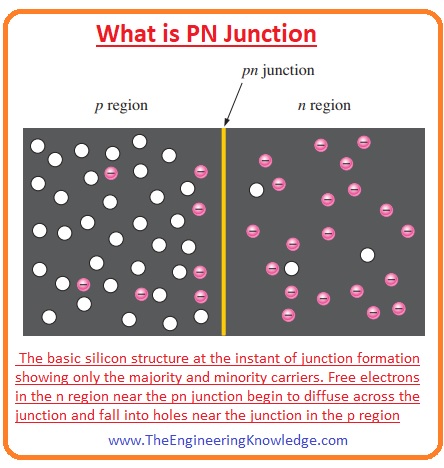
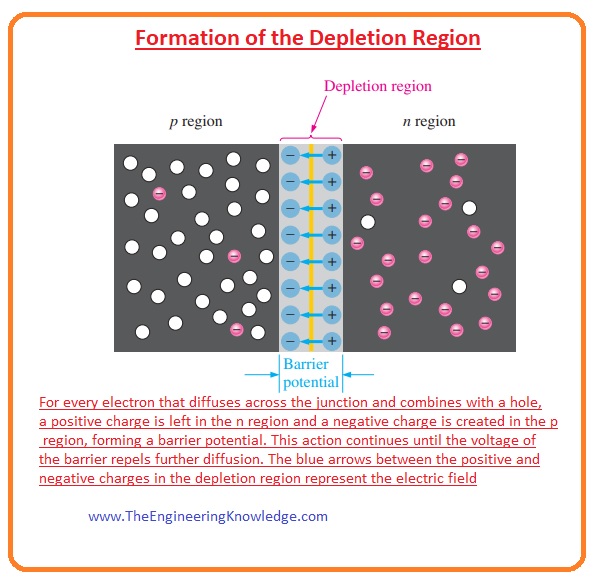
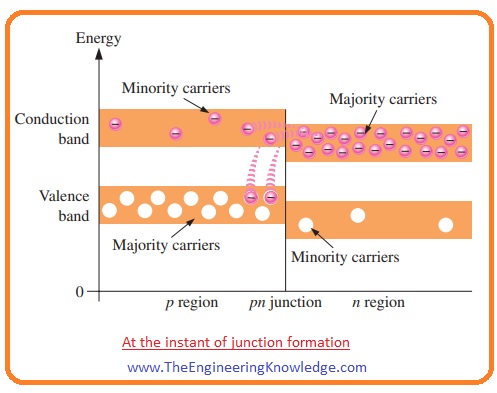
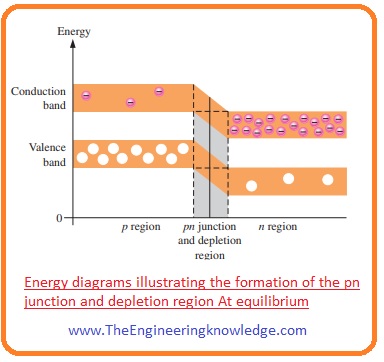




I needed to thank you for this very good read!! I certainly loved every bit of it. I’ve got you bookmarked to check out new things you post…
It composed his thoughts while reading the article amazingly
King regards,
Balle Hessellund
Thank you for your entire efforts on this blog. Betty take interest in doing internet research and it’s easy to understand why. Most people know all relating to the lively way you render very useful ideas by means of the blog and as well welcome response from other people about this article so our daughter is truly learning a lot of things. Take advantage of the remaining portion of the year. You have been carrying out a powerful job.